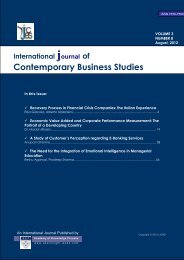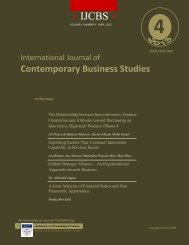Contemporary Business Studies - Academy of Knowledge Process ...
Contemporary Business Studies - Academy of Knowledge Process ...
Contemporary Business Studies - Academy of Knowledge Process ...
You also want an ePaper? Increase the reach of your titles
YUMPU automatically turns print PDFs into web optimized ePapers that Google loves.
International Journal <strong>of</strong> <strong>Contemporary</strong> <strong>Business</strong> <strong>Studies</strong>Vol: 4, No: 2. February, 2013 ISSN 2156-7506Available online at http://www.akpinsight.webs.comCoal Allocation Scam, Commonwealth Games Scam, B<strong>of</strong>ors Scam, Fodder Scam, Hawala Scam, TheIPL Scam, Adarsh Housing Society Scam, Barak Missile Scam, Kargil C<strong>of</strong>fin Scam, Mining Scam, TelgiScam and so on. The list <strong>of</strong> scams in India is never ending and unfortunately growing very fast, everyyear. The need for improving “CG and ethical culture across public and private sector companies hasnever been felt as acutely as is being felt now.” This resounding sentiment is echoed in the ‘KPMG IndiaFraud Survey (2012)’ as: “The last few years have seen increased number <strong>of</strong> frauds reported in India, aswell as, globally. From Satyam, Adidas-Reebok, Common Wealth Games and OnMobile in India toLIBOR manipulation, securities trading, over-riding international sanctions on the global front, we haveseen some <strong>of</strong> the more sophisticated and large frauds coming to light.” With reports indicating that asmuch as 5 percent <strong>of</strong> annual revenues could be lost due to frauds (ACFE 2012), organizations today arerequired to be more cognizant <strong>of</strong> the damages that frauds can do. Despite the serious risks that fraudpresents to business, “many organizations still do not have ‘formal’ systems and procedures in place toprevent, detect and respond to fraud. While no system is completely foolpro<strong>of</strong>, there are steps which canbe taken to deter fraud and make it much less attractive to commit.” All businesses are confronted withthe risk <strong>of</strong> fraud. How they respond—the nature <strong>of</strong> their approach to prevention, detection, investigationand disclosure—will separate those who manage through the issues from those who suffer significantlosses.In addition, cyber crime incidents are on the rise across the world and India is no exception to this trend.As per Norton’s Cybercrime Report (2011), “cyber crime cost the global economy (in both direct damageand lost productivity time) USD 388 billion in 2011. India is estimated to have damages <strong>of</strong> USD 7.6billion (INR 341 billion) due to cyber crime in 2011. The high cost <strong>of</strong> cyber crime is a direct result <strong>of</strong> thenumber <strong>of</strong> people defrauded by it.” Another major concern with cyber crime is its low detection level andnegligible prosecution. The monetary loss due to information theft is impossible to assess as it dependsupon the nature <strong>of</strong> information stolen. However, such losses can neither be recovered through insurancecoverage nor is the law able to protect from such incidents. However, Norton’s Cybercrime Reportmentions that close to 30 million people were affected by cyber crime in 2011 in India as against 431million globally. National Crime Records Bureau (2012) states, “India has seen an increase in the number<strong>of</strong> cyber crime cases filed. In 2011, a total <strong>of</strong> 1,791 and 422 cyber crime cases were registered under theInformation Technology Act, 2000 and the Indian Penal Code respectively, as opposed to 217 and 328 in2007.” Similarly, according to Havoscope Global Black Market Index (2012), “Intellectual propertyfraud, counterfeiting and piracy are rampant in India and no industry has been spared. Counterfeit andpirated goods in India are estimated to be worth over USD 5 billion. The global value <strong>of</strong> counterfeit andpirated goods, currently at $650 billion, is likely to more than double by 2015.” Moreover, TransparencyInternational’s ‘Global Corruption Report (2011)’ states, “The everyday face <strong>of</strong> corruption—bribes,kickbacks, tax avoidance, selling influence—is well-known and has distorted economies, demoralizedpublics and torn asunder the moral fabric <strong>of</strong> many a society.” While there is greater awareness <strong>of</strong> fraudand misconduct among corporate-sector <strong>of</strong> India, the associated risks need to be considered at a ‘strategic’level. Investments need to be prioritized to build a sustainable ecosystem that can mitigate fraudsefficiently, including frauds <strong>of</strong> the future. The KPMG India Fraud Survey (2012) has highlighted theemergence <strong>of</strong> newer forms <strong>of</strong> fraud and reliance on technology to perpetrate them. Cyber crime,intellectual property (IP) fraud, piracy and counterfeiting, and identity theft have been identified as thekey fraud risks <strong>of</strong> the future. However, in order to maintain this robust economic growth, we need anenvironment free from major risks. With terrorism going digital, we are at the threshold <strong>of</strong> ‘new’emerging risks. It is, thus, imperative for all the stakeholders, the corporate sector, government and civilsociety, to understand, analyze and address these risks.India is a ‘developing’ economy where corporate-sector is contributing a major part in national income.Most <strong>of</strong> the Indian corporations are spreading their wings all over the world where they get lots <strong>of</strong>opportunities to go for “creative” accounting since all countries have different accounting systems whichcreates ambiguity in investor’s mind. Thus, the number <strong>of</strong> accounting scandals is increasing in India.2013©<strong>Academy</strong> <strong>of</strong> <strong>Knowledge</strong> <strong>Process</strong>60
















